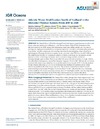Please use this identifier to cite or link to this item:
http://hdl.handle.net/10553/74649
| Title: | Atlantic Water modification North of Svalbard in the Mercator Physical System from 2007 to 2020 | Authors: | Athanase, Marylou Provost, Christine Pérez Hernández, María Dolores Sennéchael, Nathalie Bertosio, Cécilia Artana, Camila Garric, Gilles Lellouche, Jean Michel |
UNESCO Clasification: | 2510 Oceanografía 251007 Oceanografía física |
Keywords: | Arctic Ocean Atlantic Water Winter Convection Trough Outflows Mixed‐Layer Depth, et al |
Issue Date: | 2020 | Journal: | Journal of geophysical research. Oceans | Abstract: | The Atlantic Water (AW) inflow through Fram Strait, largest oceanic heat source to the Arctic Ocean, undergoes substantial modifications in the Western Nansen Basin (WNB). Evaluation of the Mercator system in the WNB, using 1,500 independent temperature‐salinity profiles and five years of mooring data, highlighted its performance in representing realistic AW inflow and hydrographic properties. In particular, favorable comparisons with mooring time‐series documenting deep winter mixed layers and changes in AW properties led us to examine winter conditions in the WNB over the 2007–2020 period. The model helped describe the interannual variations of winter mixed layers and documented several processes at stake in modifying AW beyond winter convection: trough outflows and lateral exchange through vigorous eddies. Recently modified AW, either via local convection or trough outflows, were identified as homogeneous layers of low buoyancy frequency. Over the 2007–2020 period, two winters stood out with extreme deep mixed layers in areas that used to be ice‐covered: 2017/18 over the northern Yermak Plateau-Sofia Deep; 2012/13 on the continental slope northeast of Svalbard with the coldest and freshest modified AW of the 12-year time series. The northern Yermak Plateau-Sofia Deep and continental slope areas became “Marginal Convection Zones” in 2011 with, from then on, occasionally ice-free conditions, 50-m-ocean temperatures always above 0 °C and highly variable mixed layer depths and ocean-to-atmosphere heat fluxes. In the WNB where observations require considerable efforts and resources, the Mercator system proved to be a good tool to assess Atlantic Water modifications in winter. | URI: | http://hdl.handle.net/10553/74649 | ISSN: | 2169-9291 | DOI: | 10.1029/2020JC016463 | Source: | Journal of Geophysical Research. Oceans [ISSN 2169-9275], v. 125 (10), e2020JC016463, (Octubre 2020) |
| Appears in Collections: | Artículos |
SCOPUSTM
Citations
26
checked on Mar 30, 2025
WEB OF SCIENCETM
Citations
25
checked on Mar 30, 2025
Page view(s)
143
checked on Dec 28, 2024
Download(s)
209
checked on Dec 28, 2024
Google ScholarTM
Check
Altmetric
Share
Export metadata
Items in accedaCRIS are protected by copyright, with all rights reserved, unless otherwise indicated.
